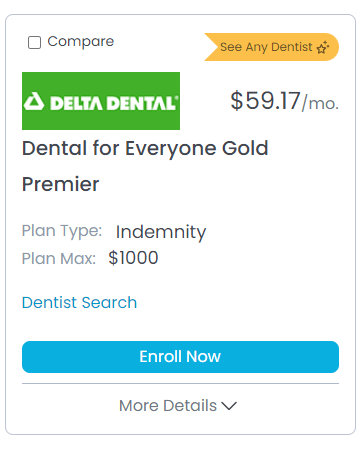 and cost summary" />
and cost summary" />  and cost summary" />
and cost summary" />We've put together the information you need when shopping for an indemnity dental plan including:
A dental indemnity plan is a fee-for-service plan that reimburses an enrollee for a portion of covered dental expenses. The reimbursement amount is not dependent on what the dentist actually charges but, rather, the insurance company's own determination of "usual, customary and reasonable" fees. Inasmuch as this is a company-specific definition, the reimbursement amounts may or may not reflect the cost of dental services within the region in which the patient lives. Depending on the indemnity plan, the patient or the patient's dentist may be required to submit a form to claim reimbursement.
In contrast to PPO and HMO dental plans, an indemnity plan typically operates without network restrictions for its members, thus allowing them to choose the dentist of their preference. This is one of the most compelling value propositions of indemnity dental plans. However, indemnity plans do have other features in common with PPO and HMO plans inasmuch as they have:
Once a more common form of dental coverage, indemnity coverage now accounts for only six percent of dental plans according to the ASDA (American Student Dental Association). Twenty years ago, indemnity plans accounted for 38 percent of dental benefits according to the American Dental Association. PPO dental insurance is now the most common form of dental coverage in the United States with over 3-in-4 dental plans being a Preferred Provider Organization.
Dental plans do not have a standardized set of benefits but indemnity plans generally are similar to other dental plans with respect to the services they cover. It is common to see some level of coverage for the following services:
In some cases, a benefit may be covered but there may be a dental waiting period requiring the insured to be on the plan for a minimum number of time before the insurance company will pay for a specific service. This is true for most dental plans whether they are HMOs, PPOs, or indemnity.
One of the advantages of indemnity plan benefits is that they can be used stand-alone or alongside other dental coverage. Some people receive dental benefits through an employer, but the coverage may come with high out-of-pocket costs. In this case, a dental indemnity plan has the potential to be used to lower these expenditures.
To see the specific dental services covered by an indemnity plan, get a free dental insurance quote and then click on the More Details arrow (see example below). If you don’t see the listing for a specific service in which you’re interested, you can click the Full Plan Information button within the More Details section.
the specific dental services covered by an indemnity plan  and cost summary" />
and cost summary" />  and cost summary" />
and cost summary" />
As mentioned earlier, the freedom of dentist choice is one of the most desirable features of indemnity dental plans. Why is this the case?
Dentists, like every other profession, evidence differences in talent and quality from one to the other. This matters to consumers because low quality dental work can:
A dentist's personality is also important. Many people have anxiety about visiting a dentist due to fears about painful procedures or shame about the status of their oral health. If a person connects with his or her dentist on a personal level, he or she may be less anxious about dental visits and more likely to keep up within annual exams and other periodic care promoting sound oral health. A recent dental insurance survey from DentalInsurance.com found that patient experience problems was a basis for switching dentists for 27.7 percent of all adults surveyed.
A Reputation Based on Trust
We do our best to provide you the best experience ever